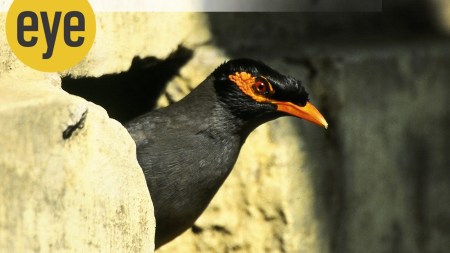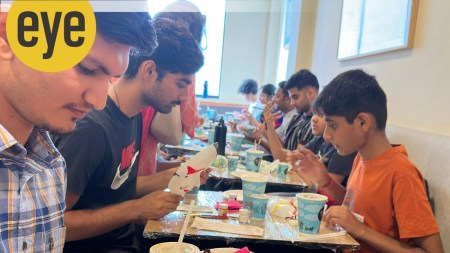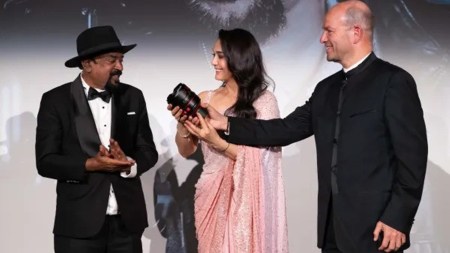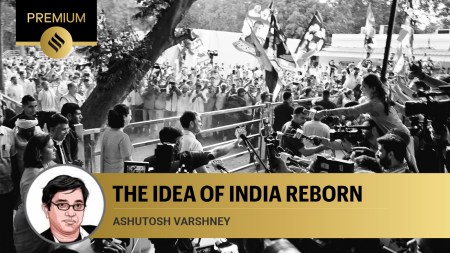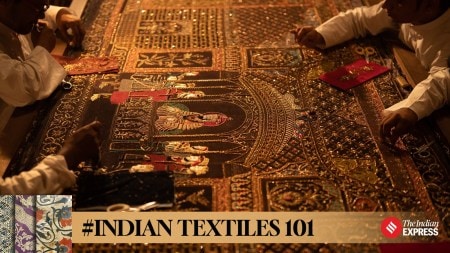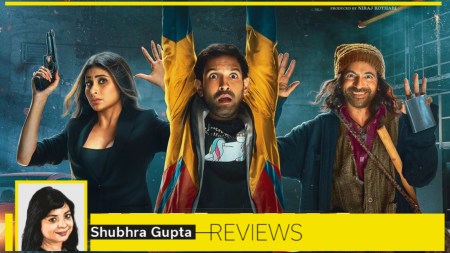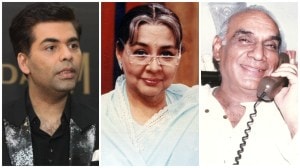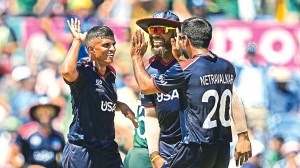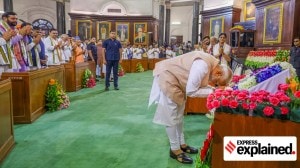- India
- International
35 years of Salman Khan: From Biwi Ho Toh Aisi to redefining the meaning of muscular fandom
Salman Khan, who completes 35 years in the Hindi film industry on Tuesday, has definitively redefined the meaning of muscular fandom, becoming one of those rare stars whose successes and failures have little or no impact on their popularity.
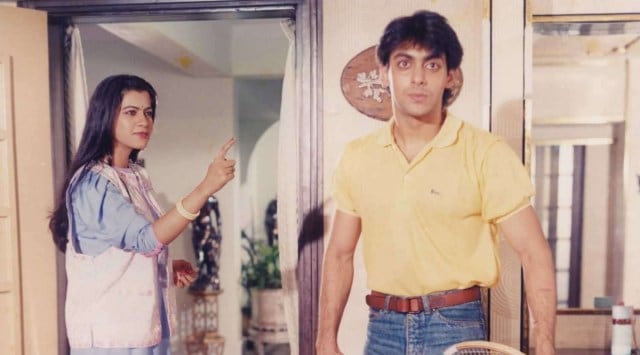 Salman Khan in a still from Biwi Ho To Aisi, which completes 35 years of release on August 22.
Salman Khan in a still from Biwi Ho To Aisi, which completes 35 years of release on August 22. There’s a sequence in ‘Biwi Ho Toh Aisi’, which came out 35 years today, giving Salman Khan his first role in Hindi cinema, in which he is dancing. Or something like that. He’s on a bed, throwing his arms and legs about, a Michael Jackson poster on the wall overlooking his antics. He’s wearing a vest and tight jeans. His hair is shoulder-length shaggy, his biceps buff, the muscles not as rock-hard as they would be, but clearly visible.
Nothing in that clunky first appearance, where he comes off as just another Bollywood hopeful, suggested that he was going to be one of the biggest stars in Hindi cinema.
The Farooq Shaikh-Rekha-Bindu starrer was one of those high-pitched melodramas that Bollywood used to churn out at alarmingly frequent intervals, featuring the kind of screechy saas-bahu clashes that Ekta Kapoor resurrected much later to great success, changing the face of Indian TV.
 Kamana, Farooq Shaikh, Suresh Bhagat, Kamani, KC Bokadia, Shabd Kumar, Rekha, JK Bihari, Bindu, Salman Kha and Renu Arya on the set of Biwi Ho To Aisi. (Express archive photo)
Kamana, Farooq Shaikh, Suresh Bhagat, Kamani, KC Bokadia, Shabd Kumar, Rekha, JK Bihari, Bindu, Salman Kha and Renu Arya on the set of Biwi Ho To Aisi. (Express archive photo)
It’s really quite a coincidence– the kind movie gods love– that from that mess also emerged Salman, who followed up his wholly embarrassing debut with Sooraj Barjatya’s mammoth hit ‘Maine Pyar Kiya’ ( 1989), which redefined youthful romance in Bollywood. ‘Dosti ka ek usool hai, madam, no sorry, no thank you’, says Salman’s smiley Prem to Bhagyashree’s simpering Suman, and that single line effectively sealed the fate, forever and anon, of those who liked to mind their ps and qs.
The high-on-family-values Rajshri production contained early warning signs of a couple of things: that Prem would become a much-used screen name of Loverboy Salman, and that that bare chest, which we kept getting flashes of through the film, was going to be such a strong signature that entire climaxes would be created around the moment Salman would go shirtless.

 Bhagyashree and Salman Khan in Maine Pyar Kiya. (Express archive photo)
Bhagyashree and Salman Khan in Maine Pyar Kiya. (Express archive photo)
‘Maine Pyar Kiya’ slung Salman to such a dizzying height of stardom, the kind people dream of and only a select few ever achieve, that he’s never really come off it, give or take a black buck or two, or a court case or few. There was only one other star at the time who could give Salman serious competition: Aamir, who also came from an established film family, had just had a huge hit in the 1988 ‘Qayamat Se Qayamat Tak’; the duo would have to wait a few more years for Shah Rukh to join them, with the 1993 ‘Deewana’, to create the enduring Khandom which has shaped mainstream Bollywood, and held us in thrall since then.
After MPK, Salman found himself in several similar knock-offs, one worse than the other. He would have sunk into oblivion, if Barjatya hadn’t rescued him with ‘Hum Aapke Hain Koun!’. There are those that gleefully called it a long ‘shaadi’ video, but that 1994 film turned out to be a landmark: it changed Bollywood in fundamental ways, whose impact we are still experiencing.
The film cemented Salman’s youthful appeal, created the super-hit pair of Salman-Madhuri Dixit, launched a purple sweetheart sari blouse which took over the bridal market, and, with its popular song “Waah waah Ramji, jodi kya banaayi,” established a clear social-religious hierarchy, in which the ‘moonhboley’ Muslim ‘chaacha’ and ‘chaachi’ are firmly relegated to the sidelines, leaving the centre-stage to be filled with a series of functions like ‘moonh-dikhai, sagaai, joota-chhupaai, vidaai, god bharaai’ interspersed with songs. We didn’t know it then, but HAHK would foreground the coming dominant cultural space: thirty-five years on, minority-religion characters have been excised from our movies, even as minor characters, unless they are villainous or superfluous.
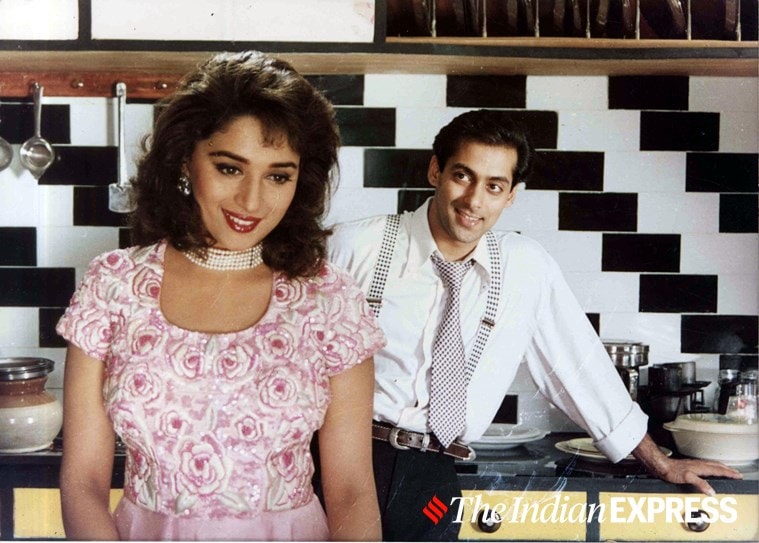 Madhuri Dixit and Salman Khan in Hum Aapke Hain Koun. (Express archive photo)
Madhuri Dixit and Salman Khan in Hum Aapke Hain Koun. (Express archive photo)
That a Muslim superstar managed to kickstart this change speaks to both an India that used to be, and the country that it was in the process of becoming. Not that Salman, son of Salim Khan, who himself once creatively partnered Javed Akhtar in writing such classics as ‘Sholay’, and ‘Deewar’, made much of his religious identity. Like the other two Khans, he just happened to be Muslim, and his legions of fans didn’t care: as far as they were concerned, Bhai (by now, there was no need to spell out Salman because there was only one Bhai; the other bad boy of Bollywood, Sanjay Dutt, was Baba), was the god of all things. He just had to appear on screen, his trademark blue bracelet to the fore, and all would well.
He has also definitively redefined the meaning of muscular fandom, becoming one of those rare stars whose successes and failures have little or no impact on their popularity. Like all stars with a long curve, Salman’s transformation from a soft Prem to the hard-edged Robin Hood in his Southern remakes (‘Wanted’, Bodyguard’, ‘Dabangg’) was a magnet for the kind of young men who would find validation in aping their beloved star’s hairstyle, arms-akimbo gait, complete with that bracelet. Nothing– alleged-drunken-driving, death-of-pavement-dwellers, shooting-of-protected-species– mattered, because their one-and-only Bhaijaan knew everything about being human. When future sociologists look back at Salman’s unique brand of stardom, they will find it buoyed by the kind of adulation that only Rajinikanth has, in which logic is dispensed at the altar of worship.
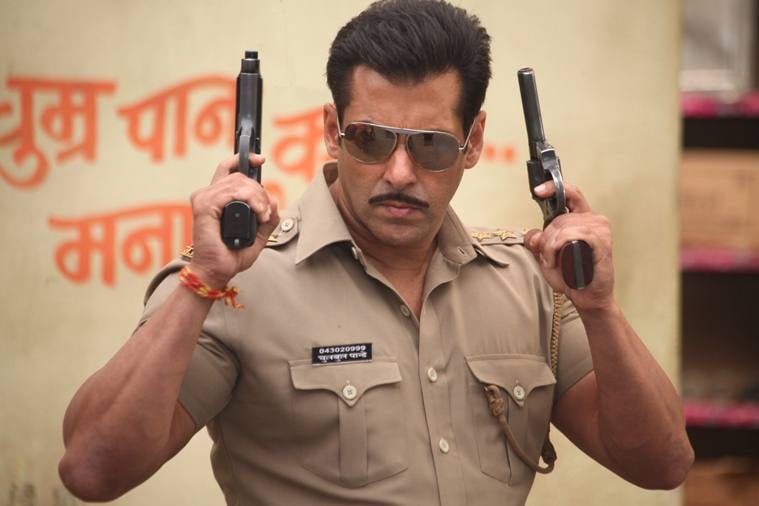 Salman Khan in a still from Dabangg 2. (Photo: Express photo)
Salman Khan in a still from Dabangg 2. (Photo: Express photo)
Looking back at his years in the industry, it’s clear that Salman hasn’t always had hits. Some of his recent films (‘Tubelight’ ughh) have been colossal duds. There is now all-round realisation that even Sallu Bhai needs a coherent plot and a strong story: those with long memories will remember his turn as an AIDS patient in Revathi’s ‘Phir Milenge’, and the tender lover in Sanjay Leela Bhansali’s ‘Khamoshi’. When he puts in the effort to move away from tropes– in Kabir Khan’s delightfully subversive ‘Bajrangi Bhaijaan’– or when he goes age-appropriate as the middle-aged wrestler in Ali Abbas Zafar’s ‘Sultan’, it makes the film better.
His cameo in ‘Pathaan’, this year’s most successful film, raised the fun bar instantly: the rueful rumination between him and SRK about not leaving Bollywood– and the country– to youngsters, is both an inside joke, and a clear sign that Bhai is not going anywhere, anytime soon. Tiger abhi zinda hai.
Click for more updates and latest Bollywood news along with Entertainment updates. Also get latest news and top headlines from India and around the world at The Indian Express.
Jun 08: Latest News
- 01
- 02
- 03
- 04
- 05


